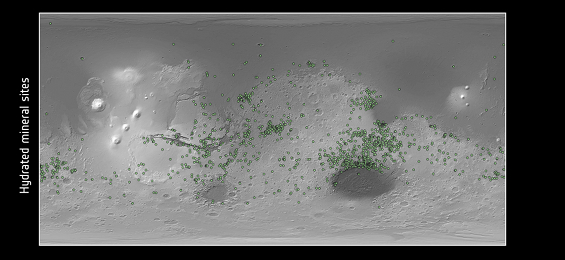Mars Express science highlights:
#1. Hydrated minerals – evidence of liquid water on Mars
Previous spacecraft images had provided indirect evidence that water must have been present in substantial quantities during the early history of Mars. These showed that the surface must have been greatly modified by water-driven processes, which left their signature in features such as dry channels, extensive surface erosion and depositional landforms such as deltas. However, such observations did not necessarily imply the stable presence of liquid water on the surface over extended periods of time.
During the last 10 years, the OMEGA visible and infrared mapping spectrometer has mapped almost the entire surface of the planet, typically at a resolution between one and five kilometres, with some areas at sub-kilometre resolution. The instrument has recorded the presence of two different classes of hydrated minerals - so called because they contain water in their crystalline structure and provide a clear mineralogical record of water-related processes.
 |
|
Map showing distribution of hydrated minerals. Credit: ESA/CNES/CNRS/IAS/Université Paris-Sud, Orsay; NASA/JPL/JHUAPL; Background image: NASA MOLA |
OMEGA has detected phyllosilicates and hydrated sulphates over large, but isolated, areas on the surface. Significantly, although both minerals are the result of a chemical alteration of rocks, their formation processes are very different. This pointed to periods of different environmental conditions in the history of the planet.
Phyllosilicates, so-called because of their characteristic layered structure ('phyllo' = thin layer), are derived from alteration products of igneous minerals (found in magma) as the result of long-term contact with water. One example of a phyllosilicate is clay.
Phyllosilicates have been detected by OMEGA mainly in the Arabia Terra, Terra Meridiani, Syrtis Major, Nili Fossae and Mawrth Vallis regions, in the form of dark deposits or eroded outcrops.
Hydrated sulphates are formed through interaction with acidic water. OMEGA has detected these in layered deposits in Valles Marineris, in extended surface exposures in Terra Meridiani, and within dark dunes in the northern polar cap.
The findings have had major implications for interpretation of the climatic history of the planet and whether it may have once been habitable. In particular, they point to two major climatic episodes: an early, moist environment in which phyllosilicates formed, followed by a more acidic environment in which the sulphates formed.
More recent observations by OMEGA have revealed some additional exposures (mostly phyllosilicates) that are scattered over the southern highlands, such as the Tyrrhena Terra region.

